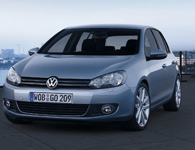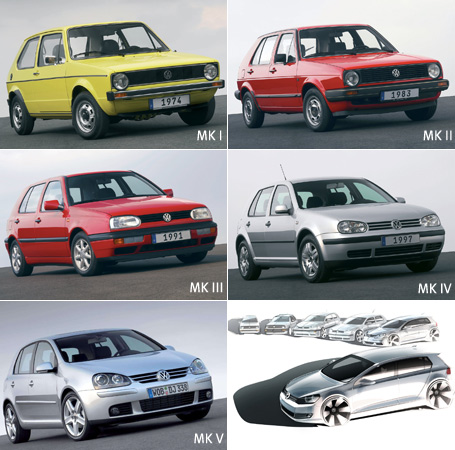Volkswagen Golf, Mark I (1974-1983)
The first Golf began production in 1974 was penned by Giorgetto Giugiaro, of ItalDesign design studio. It popularized the water-cooled, front wheel drive design pioneered by the CitroŽn Traction Avant of 1934. Rivals soon dropped the then conventional, rear-wheel drive format in favour of the Golf's front wheel drive design, as it is more fuel efficient and helps interior packaging.
The Mark I Golf was very successful during the energy crisis of the 70's, especially since it married these features with Volkswagen's reputation for solid build-quality and reliable engineering. A convertible version, named the cabriolet was sold from 1980 to 1993.
Volkswagen Golf, Mark II (1983-1991)
The second-generation Golf was launched in 1983 with a larger bodyshell and a wider range of engine options. Interestingly, there was also a version called Golf Country, designed for light off-road driving. It had more suspension travel, four-wheel drive, bullbars, a skidplate for protecting the engine area, and a spare wheel mounted externally on the back.
During the life of the Mark II Golf, there were a number of external style revisions. The most notable was the introduction of the so called "Big Bumpers", introduced in the 1989 facelift.
Volkswagen Golf, Mark III (1991-1997)
The third-generation Golf was launched in November of 1991 and for the first time a station wagon derivative was produced. Burdened by increased weight and minimal power increment, performance of the Mark III Golfs, including the GTi, was poor until the arrival of the seminal VR6 variant, with 174 horsepower. The Golf Mark III was also responsible for the diesel craze that swept through Europe in the late 1990s.
During the 1990s, Volkswagen sponsored three high-profile rock bands' European tours, and issued a special-edition Golf, with distinctive exterior markings, for each: the Golf Pink Floyd Edition (1994), the Golf Rolling Stones Edition (1995), and the Golf Bon Jovi Edition (1996).
Volkswagen Golf, Mark IV (1997-2004)
Volkswagen took the world by storm in 1997 with the Mark IV Golf, with a high-quality interior and higher equipment levels which cars of this size were not accustomed to. The rejuvenated Volkswagen iconic model went on to become the biggest selling car in Europe at one point.
Although costing slightly more than its rivals, the price difference showed when it came to luxury and upmarket feel as rivals appeared cheap. Thanks to the advent of the Mark IV Golf, many mainstream rivals in the class had to raise their game with interior quality to the point where there are now virtually no differences in quality levels between some mainstream and premium cars in the class.
Volkswagen Golf Mark V (2004-2008)
The Golf Mark IV looked "hard" but drove "soft". Volkswagen poached Ford Europe's chassis engineering team to work on the Mark V Golf. As a result, the Golf Mark V drove "hard" but looked a bit flaccid.
Slight dip in the perceived quality of the interior was also a surprise. However, the biggest surprise of all was the high production costs that lead to an early retirement of the Mark V Golf. Five years is considered short compared to the previous Golfs' life cycle. Thirty hours is needed to produce a Mark V Golf, close to double of what Renault takes to manufacture a Megane.


